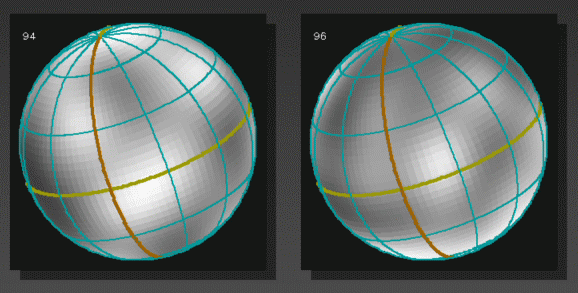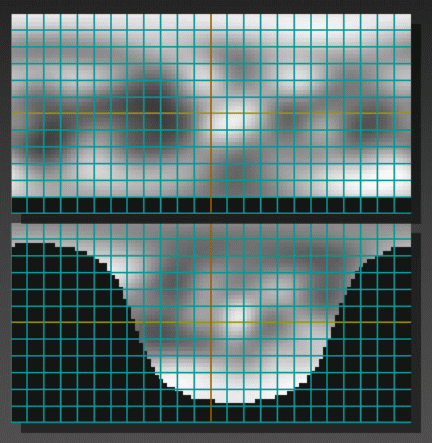New Pluto images discussed |

  |
New Pluto images discussed |
 Feb 5 2010, 05:07 PM Feb 5 2010, 05:07 PM
Post
#61
|
|
 Interplanetary Dumpster Diver     Group: Admin Posts: 4404 Joined: 17-February 04 From: Powell, TN Member No.: 33 |
They will likely be somewhat poorer in spatial resolution, since Hubble has no instrument on par in terms of spatial resolution with ACS HRC (repair not successful) and the long-since-removed FOC, the purpose will be monitoring change.
-------------------- |
|
|
|
 Feb 5 2010, 05:33 PM Feb 5 2010, 05:33 PM
Post
#62
|
|
 Member    Group: Members Posts: 593 Joined: 20-April 05 Member No.: 279 |
|
|
|
|
 Feb 5 2010, 05:50 PM Feb 5 2010, 05:50 PM
Post
#63
|
|
|
Member    Group: Members Posts: 903 Joined: 30-January 05 Member No.: 162 |
About 70 days out. Appreciate that very much. Is the correlation between resolution and magnitude similar? In other words, is the NH camera capable of exposure times and sensitivity to see objects as faint as Hubble from 70 days out? Maybe there are other satellites besides Nix and Hydra, perhaps larger, but much darker . . . . . |
|
|
|
 Feb 6 2010, 04:39 AM Feb 6 2010, 04:39 AM
Post
#64
|
|
|
Senior Member     Group: Members Posts: 1018 Joined: 29-November 05 From: Seattle, WA, USA Member No.: 590 |
I suspect they meant "hue" not "hut," but the possibility that there's a Howard Johnson's restaurant up there is hard to rule out. After all, there's one on the Space Station in the movie 2001. --Greg :-) |
|
|
|
 Feb 6 2010, 06:02 AM Feb 6 2010, 06:02 AM
Post
#65
|
|
 Interplanetary Dumpster Diver     Group: Admin Posts: 4404 Joined: 17-February 04 From: Powell, TN Member No.: 33 |
Also, there was a set taken with WF/PC2 and NICMOS in 2007. There is hope of a lower quality albedo map from the WF/PC2 data, although I don't know if this has been successful, but this would be another step in change monitoring.
-------------------- |
|
|
|
 Feb 6 2010, 04:09 PM Feb 6 2010, 04:09 PM
Post
#66
|
|
 Administrator     Group: Admin Posts: 5172 Joined: 4-August 05 From: Pasadena, CA, USA, Earth Member No.: 454 |
I think Buie mentioned during the briefing that it wasn't possible to make this sort of map with the WPFC2 data. I know he said he didn't expect to do so with the WFC3 data.
-------------------- My website - My Patreon - @elakdawalla on Twitter - Please support unmannedspaceflight.com by donating here.
|
|
|
|
 Feb 7 2010, 12:19 AM Feb 7 2010, 12:19 AM
Post
#67
|
|
 Interplanetary Dumpster Diver     Group: Admin Posts: 4404 Joined: 17-February 04 From: Powell, TN Member No.: 33 |
Quoting the abstract for the WFC3 observations, "A second goal of this program will be to retrieve a new epoch of albedo map for the surface of Pluto." With its high SNR and slightly better pixel resolution, it may be able to produce a new map.
-------------------- |
|
|
|
 Feb 7 2010, 12:30 AM Feb 7 2010, 12:30 AM
Post
#68
|
|
 Interplanetary Dumpster Diver     Group: Admin Posts: 4404 Joined: 17-February 04 From: Powell, TN Member No.: 33 |
It is worth noting that there was some darkening observed between 1994 and 1996, so it appears that this is a continuation of the process.
These are the maps from 1994 compared to those made in 1996 for "Live from the HST" (a K-12 program). BTW, Other than the fact that I participated online in "Live from the HST" chat/discussion sessions(I was in high school at the time), I have nothing to do with these images.   -------------------- |
|
|
|
 Feb 7 2010, 05:27 AM Feb 7 2010, 05:27 AM
Post
#69
|
|
|
Merciless Robot     Group: Admin Posts: 8783 Joined: 8-December 05 From: Los Angeles Member No.: 602 |
Guess the big question here is whether we're seeing effects from outgassing, or condensation of the atmosphere, or both.
If it's atmospheric 'freezing' (probably the most likely explanation), why are the presumed deposits so globally asymmetrical? Lots of interesting questions to be answered, actually; NH may have happened at precisely the correct time to do so. -------------------- A few will take this knowledge and use this power of a dream realized as a force for change, an impetus for further discovery to make less ancient dreams real.
|
|
|
|
 Feb 7 2010, 05:44 AM Feb 7 2010, 05:44 AM
Post
#70
|
|
 Director of Galilean Photography    Group: Members Posts: 896 Joined: 15-July 04 From: Austin, TX Member No.: 93 |
I think the slightest albedo difference would tend to accelerate and cause differentials like Iapetus. As the planet gets farther away, the brighter locations cool down first and get more frost first.
-------------------- Space Enthusiast Richard Hendricks
-- "The engineers, as usual, made a tremendous fuss. Again as usual, they did the job in half the time they had dismissed as being absolutely impossible." --Rescue Party, Arthur C Clarke Mother Nature is the final inspector of all quality. |
|
|
|
 Feb 7 2010, 05:53 AM Feb 7 2010, 05:53 AM
Post
#71
|
|
|
Merciless Robot     Group: Admin Posts: 8783 Joined: 8-December 05 From: Los Angeles Member No.: 602 |
Ah! Yes, true; interesting how such a recent discovery dovetails with this.
Iapetus' albedo difference is quite symmetrical, though, unlike Pluto's. Still could very well be a similar mechanism at work. Pluto has a rotation period of something like 6+ days, plus the pronounced elliptical orbit; wonder how much 'mixing' happens just from that, local terrain differences aside. -------------------- A few will take this knowledge and use this power of a dream realized as a force for change, an impetus for further discovery to make less ancient dreams real.
|
|
|
|
 Feb 7 2010, 08:04 AM Feb 7 2010, 08:04 AM
Post
#72
|
|
|
Senior Member     Group: Members Posts: 3516 Joined: 4-November 05 From: North Wales Member No.: 542 |
I think the slightest albedo difference would tend to accelerate Exactly what I was thinking. Picture different regions with different underlying albedos/textures covered in thin (partly transparent?) 'frost'. When clearing starts in a particular region the whole patch goes relatively quickly, redistributing that material to cooler regions and thus delaying the onset of clearing there - until continued seasonal warming makes the next patch go critical. Throw in the really wide seasonal temperature range expected and a multiplicity of differently coloured volatile materials and the field of possibilities seems plenty wide enough to contain these observations. It does beg the question of how complete an understanding of Pluto the severely time-limited NH observations will allow. |
|
|
|
 Feb 7 2010, 08:48 AM Feb 7 2010, 08:48 AM
Post
#73
|
|
 Junior Member   Group: Members Posts: 98 Joined: 30-November 05 From: Antibes, France Member No.: 594 |
Why are the presumed deposits so globally asymmetrical?
That's the best question we could ask here, I think! I would answer with new questions: is it fully related to the changing atmosphere (condensation, sublimation phenomena...) or is it mainly related to an internal activity? I've always thought that Pluto could'nt be classified as a normal planet due to its physical configuration. Let's recall that the relatively big moon Charon is only 19000 km from Pluto and that the center of mass is outside the sphere of Pluto. As a result, we should set a special focus on the potential tidal forces from thre second Body. Is Charon tidally-locked to Pluto? |
|
|
|
 Feb 7 2010, 01:19 PM Feb 7 2010, 01:19 PM
Post
#74
|
|
|
Solar System Cartographer     Group: Members Posts: 10146 Joined: 5-April 05 From: Canada Member No.: 227 |
Charon and Pluto are tidally locked.
Regarding explanations for the albedo patterns, presumably any model also should apply to Triton, which provides a bit of a test. Phil -------------------- ... because the Solar System ain't gonna map itself.
Also to be found posting similar content on https://mastodon.social/@PhilStooke NOTE: everything created by me which I post on UMSF is considered to be in the public domain (NOT CC, public domain) |
|
|
|
 Feb 7 2010, 01:24 PM Feb 7 2010, 01:24 PM
Post
#75
|
|
 Interplanetary Dumpster Diver     Group: Admin Posts: 4404 Joined: 17-February 04 From: Powell, TN Member No.: 33 |
Yes, although Triton has much more subdued albedo patterns. HST mapped it with FOC in 1996 and with ACS in 2005 (results are still being worked on). It also took an extensive set of Triton data with STIS in 1999.
-------------------- |
|
|
|
  |

|
Lo-Fi Version | Time is now: 19th April 2024 - 08:46 AM |
|
RULES AND GUIDELINES Please read the Forum Rules and Guidelines before posting. IMAGE COPYRIGHT |
OPINIONS AND MODERATION Opinions expressed on UnmannedSpaceflight.com are those of the individual posters and do not necessarily reflect the opinions of UnmannedSpaceflight.com or The Planetary Society. The all-volunteer UnmannedSpaceflight.com moderation team is wholly independent of The Planetary Society. The Planetary Society has no influence over decisions made by the UnmannedSpaceflight.com moderators. |
SUPPORT THE FORUM Unmannedspaceflight.com is funded by the Planetary Society. Please consider supporting our work and many other projects by donating to the Society or becoming a member. |

|